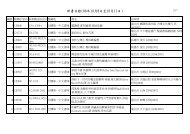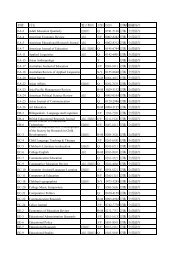??/?? - ??????
??/?? - ??????
??/?? - ??????
You also want an ePaper? Increase the reach of your titles
YUMPU automatically turns print PDFs into web optimized ePapers that Google loves.
Classification<br />
Number<br />
Table 1.2: Classification of Works of Qing Statecraft in Four Different Phases 1776-1905<br />
A.Virtuous Rule A1. Classic Learning 9.12% 7.12% 5.45% 2.85%<br />
A2. Ruling Principles 38.19% 3.52% 27.05% 7.90% 19.72% 8.18% 6.62% 1.57%<br />
A3. Rites and Customs 25.54% 12.02% 6.08% 2.19%<br />
B. Civil Service and Personnel Affairs 13.73% 7.08%<br />
5.14%<br />
6.92%<br />
C. Finance and Treasury 21.14% 21.15% 25.06% 18.97%<br />
D. Military and Security 12.66% 21.40% 15.01% 12.49%<br />
E. Law and Punishment 4.17% 4.84% 4.13%<br />
F. Infrastructure and Artisan 10.06% 10.82%<br />
G. Diplomacy and Foreign Affairs 0.00% 5.55% 5.40% 5.09%<br />
H. Science, Technology and Western Learning 0.00% 1.68% 10.75% 11.21%<br />
I. Legal and Institutional Reform 0.00% 0.40% 7.37% 23.73%<br />
(Table produced by the author, with special thank to Ms. Stephanie S. H. Weng.)<br />
本研究計畫結論如下:<br />
Phase 1: 1776-1842 Phase 2: 1843-1894 Phase 3: 1895-1899 Phase 4: 1900-1905<br />
9<br />
8.34%<br />
Collected Essays on Imperial Qing Statecraft and its sequels represented<br />
mainly the thoughts of Chinese intellectuals, degree holders, and civil officers<br />
at the core, and to a lesser extent the private literati.<br />
Works of statecraft continued culminated in 1890s and faded out in 1902 due<br />
to the new press reform, which provided outlets for intellectuals at the<br />
periphery and general public. Discussions that until then had remained<br />
largely internal to the bureaucratic elite were now transformed into a<br />
broadly-based challenge to court politics and to the process of policy<br />
formation.<br />
However the cultural success of the domestic and foreign newspapers on a<br />
variety of discursive levels after 1900s would not have been possible without<br />
the conceptual integration of the writings—stemming from official,<br />
para-official or private literati milieus—in the established structures of<br />
discourse of the Ming and Qing works of statecraft.<br />
Increasingly collected essays of statecraft started to move away from (or even<br />
discard) the principle of rule of virtue in Confucian classics (Category A [A1,<br />
A2, A3] dropping from some 45% in 1776 version to 2.61% in 1902<br />
compilation), to embrace that of creation for political, economic and military<br />
power and wealth of state (Category G+H+I rising from 0% in 1776 to a<br />
1.48%<br />
13.45%
















